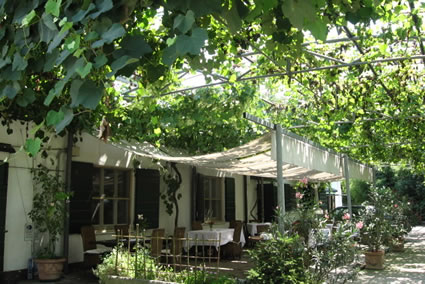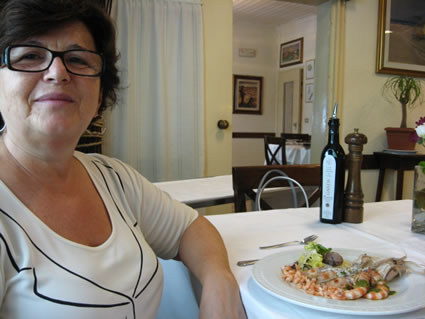Slow Food and Country Dining in Emiglia-Romagna, Italy
Finding Dining Treasures
Article and photos by Eamee C. Lanning
 |
|
Slow food dining in the great culinary region of Emiglia-Romagna of Italy is a feast for all the senses. |
Sitting on the balcony of my little Bologna apartment and looking across to a sunny green courtyard while swirling and sipping a glass of velvety Pinot Noir from the Alto-Adige, I cannot help but think fondly of my dear friends Nadia and Paolo, Bolognese born and bred, who gave me this wine as a gift. I met Nadia at the gym. When she learned I was an American university student on an exchange, she suggested giving her private ESL lessons twice a week. She and her husband Paolo travel outside Italy often, and English is handy. Our lessons, informal conversations that included as much Italian as English, frequently turned to food, so our friendship began.
One day, while having our class over coffee in a local café, Paolo called to see if we would like to drive that evening to have dinner out of town. I had heard that the best food in Italy could be found in the country at restaurants and at an Italian version of a country inn — sometimes referred to as an agriturismo. I discovered that food was fresher and more authentic by eating outside the city. Yet, I had never eaten at any of the gastronomic "institutions" for which the region of Emiglia-Romagna is so famous. I was about to get a taste of history.
La Rosa is located just outside of Ferrara in Sant'Agostino, an agricultural area of Emilia. The restaurant is celebrating 100 years in business and has produced authentic regional cuisine from its kitchen for three generations. Everything is made from scratch, down to the hot-out-of-the-oven bread and the grissini bread sticks. The wine selection is splendid. We started with a bottle of Prosecco to accompany appetizers of savory potato cream with crunchy cod (10 euros). For the first dish, I had trenette pasta with asparagus ragu (10 euros). For the secondo, a tender veal cutlet with a delicate truffle sauce (at market price), all accompanied by a bottle of dry and fruity Cabernet produced in the hills of Bologna nearby. "Mamma mia," I said to a chorus of approving nods at my selection as the veal melted in my mouth.
 |
|
You can seldom go wrong at traditional restaurants in Emiglia-Romagna, which are served by owners who cook with love. |
We were one of three tables seated that Wednesday evening. A restaurant like La Rosa is not concerned about racking up covers; its priority is service and providing a patient culture with superior cuisine. This is Italian dining at its finest. The owner, who my friends know well, conversed with us throughout the 3-hour meal with an animated Ferrarese accent about his family and their latest project. He was to open a quaint yet contemporarily designed inn situated on the property. La Locanda, as they call it, has five stylish rooms and an indoor fountain with a reflection pool (80 euros a night with breakfast). The idea was to attract tourists and business people stopping in Ferrara for a day or two and provide overnight services for diners who have driven from afar and want to stay and have yet another glass of wine rather than drive home late. It seems that the Italian law allowing authorities to repossess your car and sell it to the highest bidder if you surpass the designated maximum alcohol intake has been good for business. Regardless, we drove home feeling jolly but clear-headed and minding the speed limit.
IIn the following months, Paolo and Nadia invited me to dine at La Capanna di Eraclio in Codigoro by the Po River delta and Buriani in Pieve di Cento, both of which are within a thirty-minute drive from Bologna in the direction of Ferrara and are in relatively isolated areas. Even if you knew they existed, you would never find them merely passing by. At Buriani, I immediately noticed that they featured the Slow Food logo on their menu. Carlo Petrini from Piemonte to help raise awareness about local food traditions and to promote attentiveness to how food is cultivated and prepared. However, In Italy not every restaurant that serves such truly artisanal cuisine has adopted the logo.
 |
| Grazia Soncini, chef at La Capanna in Emilia-Romagna, holding a plate of raw baby cuttlefish |
For instance, at La Capanna, the baby cuttlefish I ate, accompanied by a delicate black sauce made from their own viscera, were hand-selected that morning from a small bay near Venezia; the pasta and the bread were all homemade on the premises, which would definitely qualify for Slow Food in my book. Buriani, a lovely white-table cloth establishment with large cottage windows, offered equally choice ingredients. I started with squill shrimp-stuffed ravioli with zucchini shavings (16 euros). I followed with a platter of five meaty lamb chops, perhaps the most tender I have ever eaten, and a fresh and subtle mint pesto sauce accompanied by a small Mediterranean feta and olive salad (18 euros). For dessert, I had molded squares of creamed chocolate tarts surrounded by chipped mojito ice and baby mint leaves (10 euros). I will never forget the pleasure on my friends' faces as they watched me eat with gusto during our evenings out together. They chuckled at the knowledge that they were presenting this American girl with a great gift by sharing all their food lovers' secrets they had acquired over the years.
I have pondered at length on Buriani's mixed seafood carpaccio of umbrine and scampi, the crisp bubbly wine for starters, and the crimson sunsets we witnessed from above the lush cultivated plains where we journeyed, and what all these restaurants have in common is the word scoperta. Scoperta means a find. Whenever Nadia and Paolo invite me for dinner, this word comes up. Would I be interested in eating with them somewhere I could discover as if stumbling fortuitously upon a hidden treasure? Yes! And they are treasures, each family run with women in the kitchen, an interesting phenomenon for eating in the country since most of the world's famous prominent city chefs remain men. And everything is of the optimum freshness. That is what I will miss most when I return to the U.S. Eating well in Italy means, you know, that the pasta was not pre-cooked, the meat was not sitting on a hotplate, and the bread was not stale. That is not to say that having a bad meal at some tourist trap in Italy is impossible, but I was under no risk of that on these occasions. In addition, each of these restaurants artfully combined the fundamental ingredients of traditional Italian cuisine with a presentation and dining experience that was wholly modern and relaxed. However, a little more of the old-school charmingly held on at La Capanna. When handed the menu, I immediately noticed there were no prices. Later, on the way home in the car, I cautiously asked, "How do you know how much things cost if there are no prices? Isn't that intimidating?" They winked at me and said, "But there were prices, just not on the ladies' menus."
Eamee Lanning has an M.F.A. in Creative Writing from New School University in New York. She is now studying abroad in Italy while working on her PhD from the University of Washington in Seattle. |
